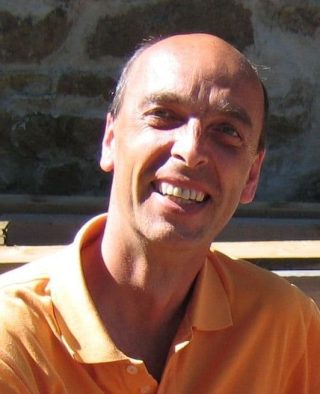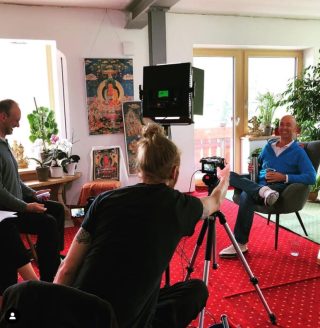
I was born in 1959. Childhood was a mixed experience, with suffering and happiness in a very human way. We are four brothers of whom I am the second, and we like each other very much, which is a wonderful gift of life. Adolescence saw me with varying length of hair and beard, warm-hearted girl friends, travelling a lot, especially hitch-hiking. Then came the medical studies, further loves, political activity, then marriage at the age of 25 in 1984.
I had started meditating in 1978, while I was still in high school. Every day I would do my ten to twenty minutes of doing nothing. But it was only in spring 1981, when I was already in medical school, that I met my first Buddhist master, the Ven. Gendun Rinpoche, a truly awakened person. At that time I was meditating in a small group of Zen practitioners without much guidance. The meeting with Lama Gendun, a Tibetan teacher, happened in the town of my studies, Freiburg in Germany, where he taught a weekend on Awakening the Heart (Bodhicitta). It was the only time he ever came there.
I felt like meeting for the first time in my life a person whose words, being and action were completely in harmony without any contradiction. This gave me the trust that “It is possible!” – to become a completely authentic person. That first teaching deeply influenced my spiritual journey for the years to come; some first understanding of Buddha nature as our potential to awaken became indelibly inserted into my heart. It was my first real introduction to the “dharma”, the teaching of the truth that liberates.
A few months later I took refuge with Shamar Rinpoche in Paris. He gave me his kind permission and enthusiastic encouragement to study meditation under teachers of the Burmese Vipassana tradition, Saya U Chit Tin and Mother Sayama, with whom I practised in nine retreats of ten days each for three years. I was also so fortunate to meditate with Anagarika Munindra at Bodh Gaya. After three years of intensive Vipassana practice, in 1984, my then-wife Irene took me to meet Kalu Rinpoche and Tenga Rinpoche. These were remarkable encounters again, and I took up practice in the Tibetan Kagyu tradition, doing my prostration/refuge and Vajrasattva practice while finishing my studies of medicine and homeopathy. Both teachers introduced me to the vast vision of the Vajrayana and Mahamudra world and their kind guidance finally let us to decide for a long retreat at the end of my studies, in 1986.
On the advice of Tenga Rinpoche we contacted Gendun Rinpoche to be our retreat guide. To make a long story short: he not only accepted us but gave us perfect conditions to meditate in closed forest retreat in France in the centre of Dhagpo Kagyu Ling (Dordogne). He visited us every 2–3 months and guided us himself, helped by his experienced students Henrik and Walli.
The retreat lasted from autumn 1986 to summer 1990, when my strong wish to take monastic vows set an unforeseen end to it. That very summer I took the Brahmacarya vows and in January 1991 he bestowed on both of us (Irene as well) the monastic ordination. He deliberately chose the name of Karma Sönam “Lhundrup” for me. We both joined the group retreat of three more years in the calm hillsides of the Auvergne, until june 1994.
This retreat place has since become the Karma Kagyu Monastery called Dhagpo Kundreul Ling with several retreat centres attached to it. From July 1994 until December 2011 I worked in this beautiful place on the request of the late Gendun Rinpoche as one of the dharma teachers in charge of the traditional 3‑year meditation retreats. Together with my colleagues I took care of five such cycles of first and second retreat, guiding practitioners in intensive individual and group practice. My work for the dharma continues now outside the monastery in a life dedicated to study, teaching meditation and writing.
I teach meditation courses in different countries, lead individual and group retreats, train dharma teachers, translate texts from the Tibetan and have started to write on a contemporary Buddhist approach close to our culture. I continue to guide practitoners in long retreats, but in less formal settings.
From 1997 to 2012 I was intensively involved in the Dharma house Croizet in France which served as a meeting place for lay people. Leading seminars on “Dharma and Psychotherapy” led in 2009 to the founding of the “Institut für Essentielle Psychotherapie” in Germany where I am one of the teachers offering a three year training in Buddhism-based Psychotherapy. And, in 2016, with a group of friends, we bought a former hotel, the “Grüner Baum” in the black forest, in Southern Germany. As the Ekayana Institute for contemporay Buddhism it serves as a retreat house for people wishing to do retreat coming from all traditions with the wish to be guided in their practice.


My activities

Guiding individual practice and retreats
My prime concern and responsability from 1994 to 2011 has been to guide the two cycles of three year group retreats for men in France, in the monastery of Dhagpo Kundreul Ling (Auvergne). This responsibility has come to an end, but I continue to take care of dharma students in Europe and Brazil. I mainly teach Mahamudra meditation and the essentials of dharma, and not so much the vajrayana practices as I did the last 20 years. I help with individual or group retreats whereever needed. However I only take care of retreats which last for a month or longer. A group of four practitioners under my guidance has started a continuous life in retreat in a house in the Auvergne. Their retreat includes taking care of their parents, cultivating vegetables and doing their own shopping. The retreat is not limited in time. I visit them every three months to spend an intensive week of teaching and practice with them.
Meditation days
Most of the Dharma texts that I wanted to translate or edit from Tibetan into German or English are now finished. Lama Johann is continuing to work on some of them. However, many of these texts are only for advanced jidam practice. However, I continue to live a rather secluded life at times and am not easy to reach. I ask for your understanding for often long delays in answering emails. During these times I devote myself to my own practice and to integrating the Dharma into socio-political and ecological tasks.
I am inspired to write about Dharma practice as something that integrates completely naturally into our Western culture. In doing so, I want to write so clearly that there are few obstacles to direct understanding. Most of these obstacles stem from our different cultural background, and I am concerned to build bridges from Buddhism to our Western spiritual tradition, philosophy, psychology, and society. In order to do this, I need to do research on certain topics, exchange ideas with others, and continue to learn a lot. Then I hope to be able to express this growing understanding in writing. We’ll see…
The first book on the subject is about psychotherapy based on Buddhist mind training, under the title “Buddhist Psychology” published by Arkana Publishing House. The book offers a summary of the contents of the three-year training at the Institute for Essential Psychotherapy in Hennef.
Brasilien und Griechenland
So far, I still go once a year to Brazil and to Greece to teach Mahamudra together with other teachers like Lama Gelek and Lama Johann. In both countries we have completed the seven-year transmission cycle to the “Ocean of True Meaning” from the 9th Karmapa. Now the focus is on integration and practice. This involves the body and nature more than before. I teach there in English, translated into Portuguese and Greek. The course in Brazil is in August in Ubatuba, Sao Paulo State and the course in Greece is on the Pelion Peninsula near Volos in the center of Greece. Participants from other countries are wholeheartedly welcome.
Deutschland
With the foundation of the Ekayana Institute I have cancelled almost all other events in Germany, because my energy is needed here in the retreat house. But I continue with 2 weekends a year in Freiburg the explanations to the meditation manual of the 9th Karmapa “Mahamudra – Ocean of True Sense”.
The transcripts of the many previous seminars in Möhra, Remetschwiel and Munich can be found in our media library.
The eight-day Mahamudra retreats twice a year and also the Vajrayana courses before and after New Year, which have already become a tradition, now all take place near the Grüner Baum, either in the Kulturhaus Raitenbuch or in the large festival hall of the community of Lenzkirch.
So, now you have gained an overview of my regular activities. You can find more information on the calendar of the homepage.
With best wishes, Lhündrup
